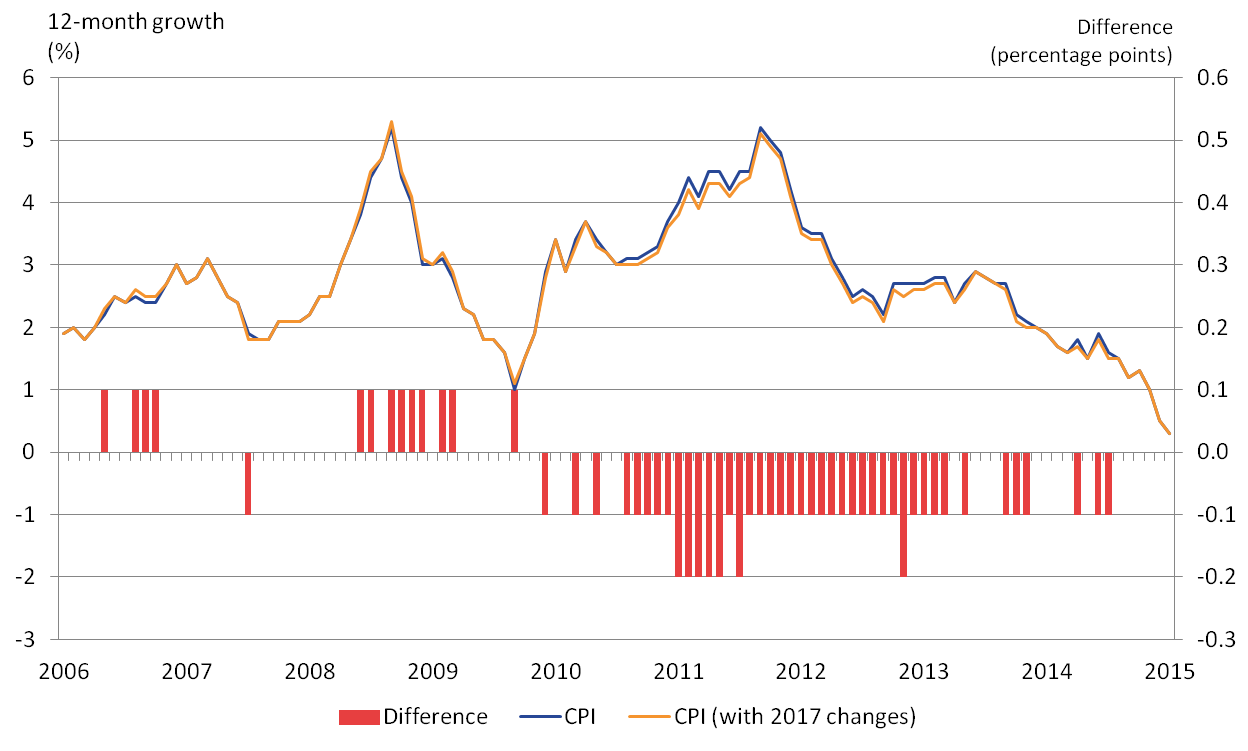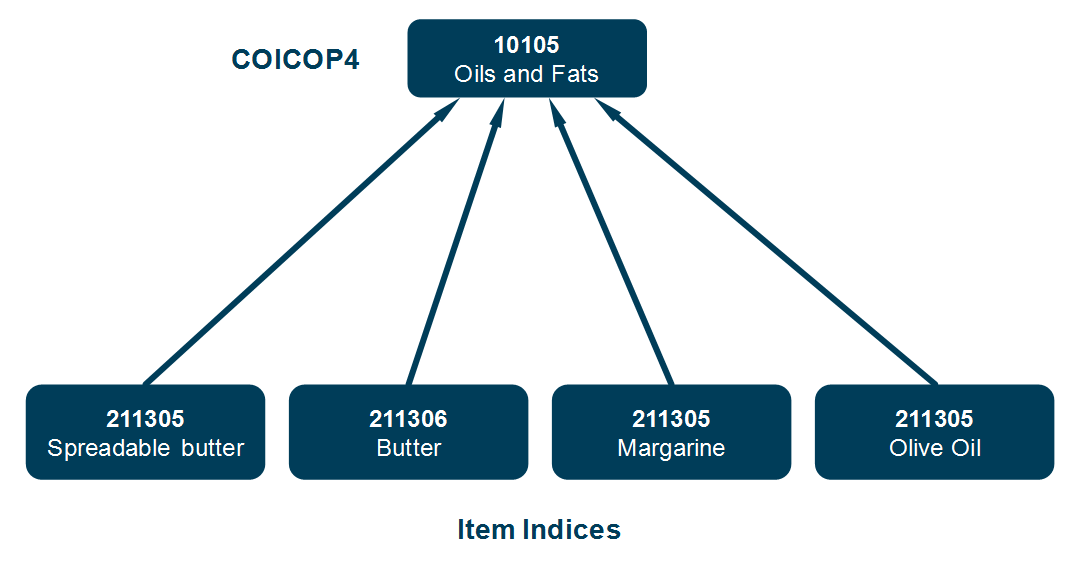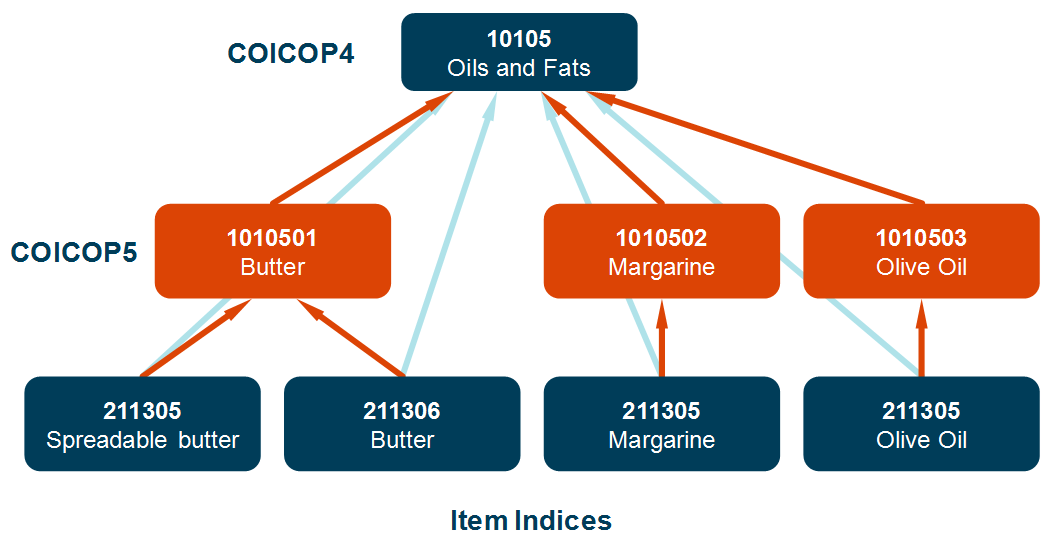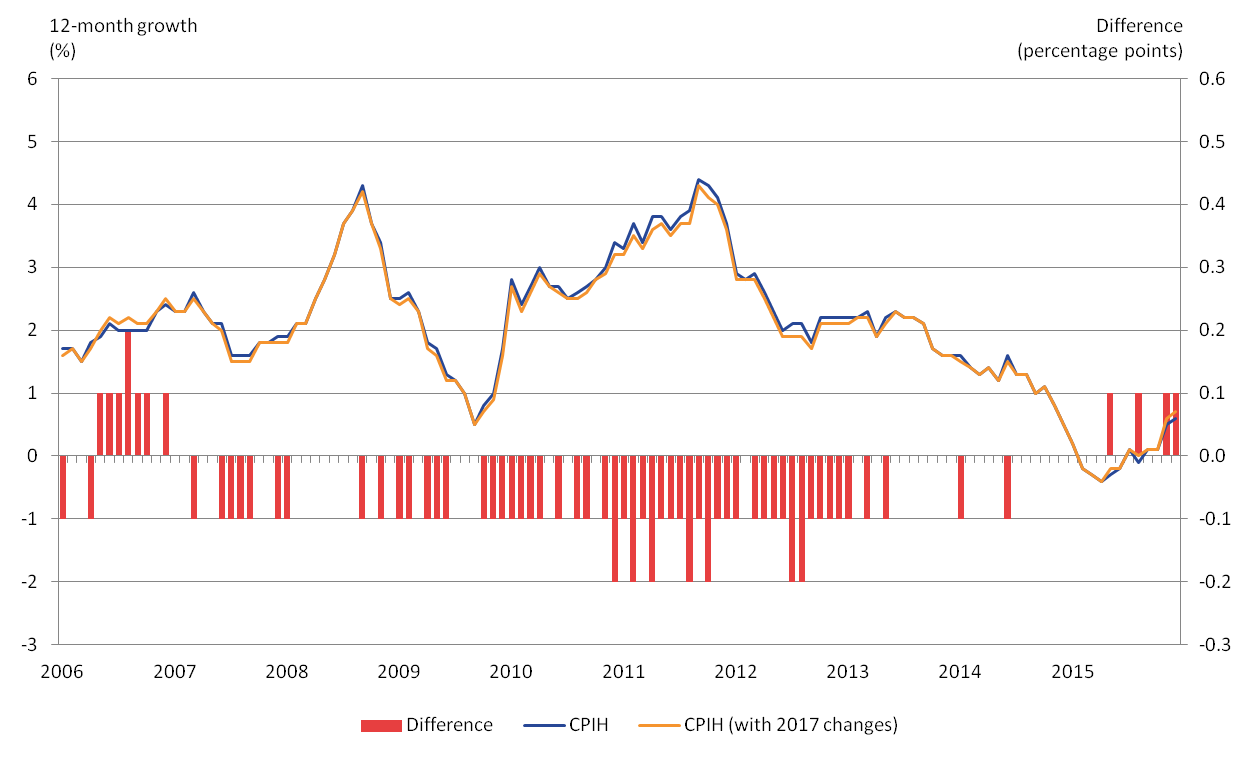1. Summary
In March 2017 we will publish CPI and CPIH at an additional level of aggregation below the current COICOP1 Class (COICOP4) level. This level is known as COICOP5 (referred to by Eurostat as ECOICOP). At the same time, we will be making a change to the methodology for chain linking in CPI and CPIH.
Based on analysis conducted on CPI data between 2005 and 2015, the expected impact of the two changes on the headline CPI is a reduction in the 12-month growth of between 0.0 and 0.1 percentage points in most months, as shown by Figure 1.
Figure 1: CPI and CPI with 2017 changes, rounded 12-month inflation rate
UK, 2006 to 2015

Source: Office for National Statistics
Download this image Figure 1: CPI and CPI with 2017 changes, rounded 12-month inflation rate
.png (44.7 kB) .xls (40.4 kB)Notes for Summary:
- COICOP (Classification of Individual Consumption According to Purpose) is a classification scheme defined by the United Nations and used by us and Eurostat to group products in the HICP.
2. Explanation of the changes
2.1 The “double link”
A double chain link is used in the UK to address the practical problem of using the same price data for both the Retail Prices Index (RPI) and the Consumer Prices Index (CPI). CPI is identical to the HICP, an inflation measure designed by Eurostat to be comparable across member states. RPI prices are collected on a January to January cycle but Harmonised Index of Consumer Prices (HICP) regulations require Classification of Individual Consumption According to Purpose (COICOP) weights to be updated each December. Therefore the UK version of the HICP employs one chain link in December to include the new weights and a second chain link in January to include the new price reference period.
The CPI is a Lowe price index, meaning that quantity weights should be fixed at some point in the past1. In order to construct weights, expenditure data are collected for the required period and then “price updated” to the price reference period (January for CPI, December in other countries’ HICPs). However, for 11 months of the year in the CPI, the month to which weights are price-updated (December) and the price reference period (January) are different.
We have worked with Eurostat to improve the double chain link methodology and, in October 2015, Eurostat initiated an independent review which proposed price updating weights twice a year for the CPI. The resulting index would then be “mathematically identical to an index with a single chain link”.
Therefore, in January, CPI uses weights price updated to December (as it does already), but from February to December, it uses weights price updated to January. These changes will correct an existing bias in the CPI, and the double updating of prices brings the CPI mathematically in line with a single December link index.
This method will be implemented into the HICP in March 2017.
Notes for 2.1 The “double link”:
- Two years before price collection in the case of the CPI, due to availability of high quality expenditure data.
2.2. The introduction of COICOP5
In March 2017, we will publish CPI and CPIH at an additional level of aggregation below the current Class (COICOP4) level. This level is known as COICOP5, or ECOICOP5. COICOP5 will sit between the existing class (or COICOP4) level indices and item level indices. Figure 2 depicts the current CPI structure for reference, and Figure 3 gives an example of how COICOP5 fits into the structure.
Figure 2: Example of current COICOP structure in the CPI

Source: Office for National Statistics
Download this image Figure 2: Example of current COICOP structure in the CPI
.png (110.5 kB)The introduction of COICOP5 necessitates a change to the aggregation structure of CPI and CPIH. In essence, the COICOP5 sub-classes replace the existing COICOP4 classes as the first building block above the item level. An example is presented in Figure 3.For a detailed list of COICOP5 categories, see the Eurostat Reference and Management Of Nomenclatures.
Figure 3a: COICOP4 level structure for Oils and Fats

Source: Office for National Statistics
Download this image Figure 3a: COICOP4 level structure for Oils and Fats
.png (13.1 kB)
Figure 3b: Introduction of COICOP5 level weights

Source: Office for National Statistics
Download this image Figure 3b: Introduction of COICOP5 level weights
.png (49.4 kB)Testing the implementation of COICOP5 in an offline system has demonstrated that adding COICOP5 into the CPI aggregation structure can result in differences in indices at higher levels of aggregation. The differences come from the way in which the double chain link described in 2.1 is applied. Calculations for the double link currently occur at the COICOP4 level. As a result of this difference it is recommended that the second link should be applied at the item level when implementing COICOP5 rather than moving the calculation to the COICOP5 level.
Applying the second link at the item level when implementing COICOP5 will result in an index that is more robust to changes in classification and aggregation methods in the future, and ensure that the aggregation methodology is consistent at all levels.
Back to table of contents3. Analysis of the impact
To assess the impact of these changes, we used an offline system to re-calculate the Consumer Prices Index (CPI) from 2006 to 2014 under a number of scenarios.
3.1 Changing the “double link” methodology
The impact of continuing to use weights price updated to December in the January index, but using weights price updated to January between February and December was tested. The impact on the rounded 12-month growth rate (as shown in Figure 4) is to reduce it by 0.1 percentage points in most months, although in some months it falls by as much as 0.3 percentage points.
Division 7: Transport is the main driver of this fall, and in particular Group 7.3: Transport Services. Investigations into this area revealed that there are large decreases in price between December and January, which are in turn influencing the double price updated weights. See Annex B for further details of the impact at divisional levels.
Figure 4: CPI and CPI with double price update, rounded 12-month inflation rate
UK, 2006 to 2015

Source: Office for National Statistics
Download this image Figure 4: CPI and CPI with double price update, rounded 12-month inflation rate
.png (57.8 kB)3.2 The introduction of COICOP5
The impact of moving double link calculations to the item level (necessitated by the introduction of COICOP5) can be seen in Figure 5. An example of the changes is given in Annex A. The impact on the rounded 12-month growth rate is to increase it by 0.1 percentage points in around a quarter of the months in the analysis.
Figure 5: CPI and CPI with COICOP5 (double chain link calculations at item level), rounded 12-month inflation rate
UK, 2006 to 2015

Source: Office for National Statistics
Download this image Figure 5: CPI and CPI with COICOP5 (double chain link calculations at item level), rounded 12-month inflation rate
.png (32.5 kB)3.3 The combined effect of both changes
Both the double price update and introduction of COICOP5 will be implemented in the CPI and CPIH in March 2017. The impact of their combined effect is to reduce the 12-month growth rate by between 0.0 and 0.1 percentage points in most instances, as shown in Figure 1 and summarised in Figure 6.
Figure 6: Distribution of differences between CPI and CPI with 2017 changes
UK, 2006 to 2015
Source: Office for National Statistics
Download this chart Figure 6: Distribution of differences between CPI and CPI with 2017 changes
Image .csv .xlsThe larger differences seen with the implementation of the double price update (up to -0.3 percentage points) would be partially off-set by COICOP5 changes. This is shown in Figure 6, which compares the distribution of differences from the CPI when implementing either both changes or just the double price update. The impact at the divisional level is similar and is presented in Annex B.
Figure 7: Distribution of changes from the CPI with implementing both 2017 changes or just the double price update
UK, 2006 to 2015
Source: Office for National Statistics
Download this chart Figure 7: Distribution of changes from the CPI with implementing both 2017 changes or just the double price update
Image .csv .xls4. Impact on CPI and CPIH
The Consumer Prices Index (CPI) and CPIH are not interlinked in quite the same way as the CPI and Harmonised Index of Consumer Prices (HICP). However, CPIH is currently identical to the CPI with the addition of owner occupiers’ housing costs (OOH). The same changes will also be made to CPIH, as they represent a methodological improvement, and to maintain this relationship between the CPI and CPIH.
These changes have a smaller effect on CPIH. Prices for OOH in December are often very similar to prices in the next January. For this reason the updating factors applied to expenditure data are similar for the two months – this is presented in Table 1.
Table 1: Owner-occupiers’ housing costs weights price updating to December and January
| Index Year (y) | 2009 | 2010 | 2011 | 2012 | 2013 | 2014 | 2015 |
|---|---|---|---|---|---|---|---|
| PU Factor to Jan y | 104 | 99.7 | 99.7 | 102.5 | 102.5 | 102.1 | 102.7 |
| PU Factor to Dec y-1 | 104 | 99.9 | 99.5 | 102.4 | 102.5 | 102.1 | 102.4 |
| Source: Office for National Statistics | |||||||
Download this table Table 1: Owner-occupiers’ housing costs weights price updating to December and January
.xls (26.1 kB)This means that the effect on weights is similar for weights price updated to January and weights price updated to December and, as a result, the differences seen in HICP are lessened for CPIH. Figure 7 shows the 12-month growth in CPIH alongside the 12-month growth in CPIH with a double price update and COICOP5 introduced, as recommended above.
Figure 8: CPIH and CPIH with 2017 changes, rounded 12-month inflation rate
UK, 2006 to 2016

